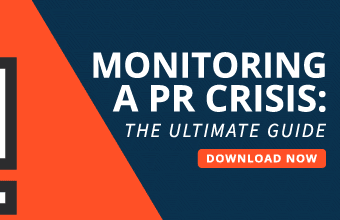Chatbots are an incredible tool for maximizing your marketing potential. They can help you to develop customer trust and they can improve your customer engagement. But many businesses don’t realize just how beneficial they can be during a crisis, mainly because they don’t even understand chatbots to begin with.
Business-to-business and business-to-customers companies are utilizing chatbot technology as sales support, customer service, booking agents and more. In fact, over 25 percent of U.S. adults are more than happy to purchase products from a chatbot.
But, while these stats seem great for the industry, there is one area where chatbot use is falling needlessly short: crisis management.
While chatbots might help with customer service or sales, putting them to use as a crisis communication tool might just be the most useful implementation of them yet, especially when it comes to protecting your business’s reputation.
The development of chatbots
The first chatbot, Eliza, was introduced to the world in 1966. Created at MIT by a man often considered one of the fathers of artificial intelligence, Joseph Weizenbaum, Eliza ran very simple scripts designed to imitate a therapist. Eliza would respond to user inputs with key pre-scripted responses.
While Eliza was far from capable of responding to the complex queries that modern chatbot’s handle, it kick-started the concept of users having in-depth interactions with chatbot technology – a concept that remains extremely relevant today.
Nearly 60 years later, Facebook alone is running around 300,000 independent chatbots, which are actively exchanging over 8 billion messages each month. And again, that’s just Facebook.
How to use chatbots in a crisis
The performance of the American economy is currently very strong for individuals and businesses alike according to several indicators, including higher levels of personal disposable income, and an overall unemployment rate that has fallen under 5 percent.
But this doesn’t mean that businesses are immune to crises or breaches, and if anything, the threat now is greater than ever before. If your company were to suffer a major data breach that exposes the personal and/or financial information of your customers, for example, you would have a major crisis on your hands and the ability to respond to the questions and distresses of customers will be of paramount importance. This is where chatbots can come in handy.
Today, a countless number of businesses are using chatbots and exchanging millions of messages of their own. In the 2018 State of Chatbotsreport, it was noted that the most predicated use for survey respondents was to get answers in emergencies and get them fast—with over 35 percent of respondents reporting that they planned to use them for that exact reason in future.

When a crisis hits, it’s difficult to accurately gauge where affected members will seek out information. Alongside managing the situation with the proper management tools, you need to cater to your customer’s needs. In order to help users gain access to a chatbot that will provide them with the most value, it would be most effective to set up multi-platform, multi-page chatbots that pop up to help funnel information to users as they need it.
These could be on FAQ pages, social media pages, and even your homepage, and must be accessible on both desktop and mobile. The chatbot should also encourage visitors to ask questions so that the chatbot can feed them the right answers, and establish itself as a helpful resource during their crisis.
Using chatbots to reduce message volumes
Companies are swamped every day with emails, social media messages, calls, and sometimes, complaints. The more widespread the crisis, the more messages the company will receive, and the more it needs to be able to step up and handle it. But in most scenarios, companies are too ill-equipped to deal with the volume of messages they’re receiving.
By using chatbots as part of your crisis management plan, you can handle an enormous quantity of traffic, conversations, and customer service. By having a bot that handles questions from multiple different customers, across multiple different devices, you free up the resources of your team to help those who require more complex assistance than the chatbot can offer.
Chatbots, after all, cannot help every customer. Where questions are simply issues that boil down to a lack of information, a chatbot is ideally placed. But remember to use message prompts that help a customer reach out to a human representative when the chatbot isn’t capable of helping them.
On top of that, you also want to ensure your chatbot can communicate with your team and flag the customer as one that needs to be contacted as soon as possible.
Leveraging chatbots to improve the accuracy of your messages
Small to medium sized businesses are exposed to a staggering number of vulnerabilities each and every day, and any major controversy or data breach that were to result from your own company falling victim to cyber criminals would be sure to result in a major crisis that would result (at the very least) in your customers becoming very worried and demanding answers.
In such a crisis, the last thing you want to do is feed your customers with inaccurate information. But when your business is overwhelmed with customer queries, it is extremely difficult to ensure that every customer interaction is 100% accurate. This can lead to extending a customer’s crisis and damaging your company’s reputation.
This is why one of the biggest failings of companies who do employ chatbots is that they do not ensure their message bank is accurate and regularly updated. After all, if the message bank isn’t accurate, then neither will the chatbot. Ideally, you want a dedicated employee to keep the chatbot message bank regularly updated throughout the day.
In many cases, your customer base will need to be regularly updated—and not just at scheduled times. If the crisis is severe, you may need to communicate regularly with your entire customer base.
Having a chatbot that can handle key questions and provide immediate answers is necessary, but you’d also want it to be able to update huge swathes of your customer base, on the fly, potentially on an hour by hour basis. You could even use push-notifications to keep your updates front and center on their devices.

That said, nobody wants to be inundated with spam messages. In most cases, it gets filtered and won’t be read by anyone. This goes for any communication platform on the planet, and chatbots are included. If you do have to use push notifications, ensure they’re used for only the most important updates.
Conclusion
If you take away anything from this article it should be this: chatbots are far more than a somewhat useful tool in your crisis management plan.
They are a vital tool that can field thousands of customer questions, free up time and manpower, allowing you to help the customers most in need, maintain your reputation and keep your customers happy.
The article was originally published on March 18, 2020 and was republished on March 18, 2021








